#luxury vehicles India
Explore tagged Tumblr posts
Link
Mercedes-Benz has introduced the groundbreaking Mercedes-AMG C 63 S E PERFORMANCE, which features the world's most powerful four-cylinder engine coupled with innovative Performance Hybrid Technology derived from Formula 1. This
#Mercedes-Benz#Mercedes-AMG C 63 S E PERFORMANCE#F1 hybrid technology#luxury cars India#hybrid performance#Delhi NCR#retail of the future#luxury car dealerships#C-Class#performance hybrid cars#luxury vehicles India#AMG C 63 S#hybrid cars#luxury automotive#luxury dealerships#Silver Arrows#performance sedans India#Mercedes-Benz India
0 notes
Text
#Bulletproof Cars in India#Bulletproof Luxury Cars In India#bulletproof cars manufacturers#Bulletproof car manufacturers in India#bulletproof vehicle manufacturers in India
2 notes
·
View notes
Text
BMW Car Price Hike in India. Everything You Need to Know
BMW car prices set to rise in India. Find out how the recent BMW car price hike impacts the cost of BMW car models across all segments.
#automotive#auto news#automobile#autos#cars#news#luxury cars#electric cars#electric vehicles#BMW#BMW India
0 notes
Text
One of the biggest advantages of electric cars is that they are noise-free vehicles. Traditional petrol or diesel cars often produce a lot of noise, especially in heavy traffic, which can be annoying and stressful. Electric cars, on the other hand, run much quieter, giving drivers a smooth and peaceful ride. This noise reduction also benefits city life, as it reduces the overall noise pollution in crowded urban areas, contributing to a more peaceful environment.
0 notes
Text
Discover the freedom of travel with TripMoments! Our reliable car rental service offers a diverse fleet of vehicles to suit every adventure—whether it’s a weekend getaway or a cross-country road trip. Enjoy competitive rates, easy booking, and exceptional customer service. Your perfect ride is just a click away. To get more information call us @ 8800904002
#Car Rental Service in Delhi#Rent a car in India#Car rental deals#Affordable vehicle rentals#Last-minute car rentals#TripMoments car booking#Car rental India#Budget car rentals#Rent a car for travel#TripMoments vehicle hire#Easy car booking online#Family car rentals#Luxury car rentals in India#Car rental service#Affordable car rentals#TripMoments car hire
0 notes
Text
Shield Armoring has set the standard in the design and development of Luxury Armored Vehicles Bulletproof BMW. Visit : https://shieldarmoring.com"
#Bulletproof Cars in India#Bulletproof Luxury Cars In India#bulletproof cars manufacturers#Bulletproof car manufacturers in India#bulletproof vehicle manufacturers in India#Top Armored Cars Company in India#bulletproof luxury cars#Armored Vehicle Manufacturers In India#top armored car manufacturers#Armored Vehicle Company#top armored car companies
1 note
·
View note
Photo

Raiders, Rulers, and Traders: The Horse and the Rise of Empires
Chaffetz deftly illustrates the vast history of Asia and its great empires -- Chinese, Persian, Indian, and Mongol -- through a history of horsepower. The cultures of the people of the steppe, their religions, technology, and migrations also come into play. Expertly, Chaffetz shows that horse breeding and trading, not the fabled Silk Road, linked these historical forces together over time and distance.
The Silk Road may have carried the world’s most luxurious fabrics for trade, but it was paved with horses’ hooves. From the Bronze Age to the 20th century, the empires of China, Persia, India, and Mongolia conquered astride the backs of horses. By focusing on the history of the horse in Raiders, Rulers, and Traders, David Chaffetz provides fascinating insights into conquests in history, from the Persian Empire of Cyrus the Great to the Russian Empire of Alexander II.
Chaffetz traces the evolution of the horse from a wild animal of the Eurasian steppe to its place at the center of war and commerce over almost 3,000 years of human history. The earliest horses weren’t much larger than donkeys. He shows that the first domesticated horses pulled carts and chariots — as it took centuries of breeding until they were strong enough to carry humans. The breeds of horses reflected the cultures that adopted them: the sleek, speedy raiders of Arabia; the huge, powerful Persian steeds; and the sturdy Mongol breeds whose endurance and ability to thrive in harsh conditions were key to Ghengis Khan’s continent-spanning conquests. Maps of the Eurasian Steppe in every chapter help readers to keep track of the disparate locations, and illustrations show the artifacts that these cultures created to celebrate horsemanship.
Of the empires covered in the book, China gets a special focus. The Great Wall was built by the Qin Dynasty in the 2nd century BCE to protect the northern frontier from horse-mounted raiders. Yet China needed horses for its own armies, and large-scale horse breeding was difficult in the hills and fertile valleys south of the wall. A sophisticated trading network grew along the frontier in which trade goods like silk and tea were traded were exchanged for animals.
The Silk Road grew in the wake of a 1st-century BCE military expedition led by the Hun general, Li Guan Li, to find the “blood-sweating” Ferghana horses that nomads had described to Chinese horse traders. Braving high mountain passes and arid wastes in a journey that presaged those of Coronado and Lewis & Clark in North America, Li laid siege to a citadel near the present-day Kyrgyz city of Aravan. His reward was 300 of these “celestial horses” along with a promise of 2 horses every year thereafter. These yearly journeys, and the return of payments of silk and other commodities, established the Silk Road.
Indian emperors also relied on imported horses from central Asia. In a region whose jungles and deserts were unsuitable for breeding horses, huge trade fairs arose across India, where rajas met Afghani horse breeders to do business. Like China, India faced waves of horse-borne invaders from Afghanistan and Persia. As the sea trade with Arabia and, later, Europe developed, southern Indian rulers gained key means to defend their lands.
Horsepower remained the key to empires into the dawn of the 20th century, during which gasoline-powered vehicles arose. In later chapters Chaffetz covers Britain’s strained efforts to breed horses in India – and strike deals with Afthani traders – as well as the Russian Empire’s use of cossack cavalries to conquer the steppe.
In appendices, Chaffetz details the prices of horses in China and India in both historic and present-day terms. A timeline connects concurrent developments in the Western Steppe (Persia) the Indian Subcontinent and the Eastern Steppe.
Chaffetz writes frequently for publications like Asian Review of Books and is a member of the Royal Society for Asian Affairs. Raiders, Rulers, and Traders is a broad history that will augment readers’ knowledge of the great empires of Asia. Its focus on horse husbandry is a useful gateway into history for reluctant learners.
Continue reading...
18 notes
·
View notes
Photo






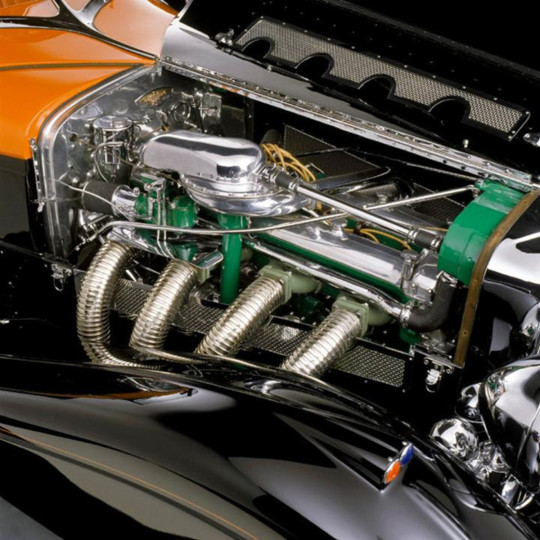

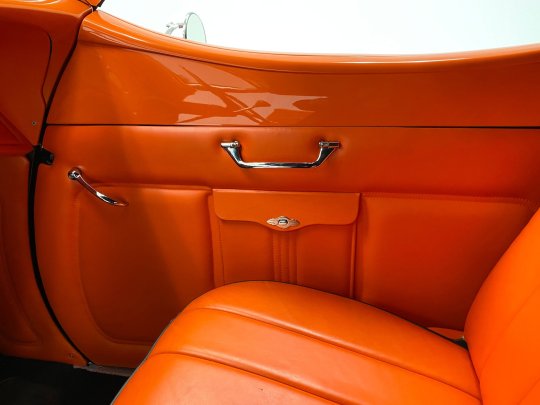
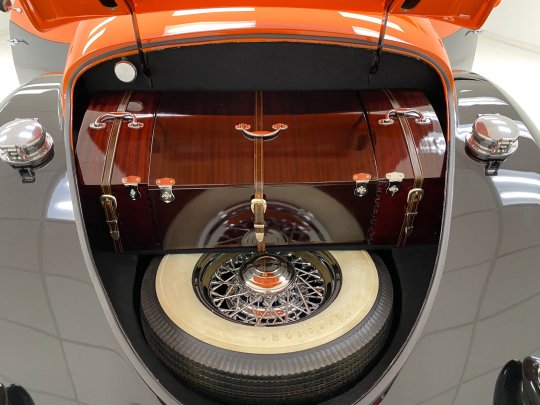
1935 Duesenberg SJ Gurney-Nutting Speedster
The Speedster body was fitted to chassis number 2614, which is believed to be the last Duesenberg chassis produced in 1935. The body was designed by A. F. McNeil and built by J. Gurney Nutting & Co. Ltd. in the fashionable Chelsea district in London.
The one-of-a-kind luxury automobile was built for Maharaja Holkar of Indore, India and commissioned through a British sales agent R.S.M Automobiles Ltd of London.
Destined for a life of royalty, the Gurney Nutting Speedster was built with unique, lavish features including a rumble seat with a concealed fold-down step built into the sides of the body for easy access, as well as red and blue lights on the front fender to indicate whether the Maharaja (red) or Maharani (blue) was driving the vehicle.
Upon its completion, the Duesenberg was delivered to the Maharaja’s mansion in Santa Ana, California due to fears of Japan invading India. After the tension in the region dropped, the automobile was shipped to India, then disappearing over time and thought to be lost until its rediscovery in 1959.
The outstanding auto was brought back to the U.S., eventually acquired by General Lyon. Restored with all of its royal touches retained, the 1935 Duesenberg placed first in the Maharaja Class at the 2012 Pebble Beach Concours d’Elegance and will now be showcased at the 2019 La Jolla Concours d’Elegance under the Registered Class: American Classics Open (1920-1948).
#art#design#sportcars#sportcar#vintagecars#vintagecar#peedster#india#classic cars#classic car#gurney nutting#royal#duesenberg#duesenberg gurney nutting speedster#indore#holkar#1935#luxurycars#luxurylifestyle#luxurycar#one-off#unique car
234 notes
·
View notes
Text

1957 Chevy
The Legendary “Black Widow” 1957 Chevy: A Piece of Racing History
When it comes to legendary cars, the 1957 Chevrolet, also known as the “Black Widow,” holds a special place in the hearts of car enthusiasts. However, few people know the intriguing story behind this iconic vehicle. In this article, we will take you on a journey through time and explore the fascinating history of the Black Widow.

The Secret Support Behind the Scenes
In the 1950s, car manufacturers were prohibited from directly promoting racing. Nevertheless, behind closed doors, Chevrolet found a way to support the racing community. They collaborated with a company called SEDCO to build a limited number of race-ready 1957 Chevys. Only 18 of these incredible vehicles were ever produced.

Unleashing the Beast
To create the ultimate racing machine, Chevrolet started with the lightest model available, the no-frills 150 utility sedan. They then equipped these cars with high-performance drivelines that would leave their competitors in awe. The Black Widows proved to be astonishingly fast, setting records and securing multiple victories on the track.

Restoring the Legend
One particular Black Widow has undergone an extensive body-off-frame restoration, meticulously recreating its original glory. The attention to detail is impeccable, resulting in a pristine body that is arguably even better than when it first rolled off the factory floor.
Exquisite Exterior
Painted in the iconic Black Widow colors of Onyx Black and India Ivory, the exterior of this restored beauty is nothing short of breathtaking. Every panel is laser straight, and the gaps are precise. There isn’t a hint of rust or damage to be found. The flawless paint job has been polished to a mirror-like finish, allowing you to see your own reflection. It’s like holding history in your hands.
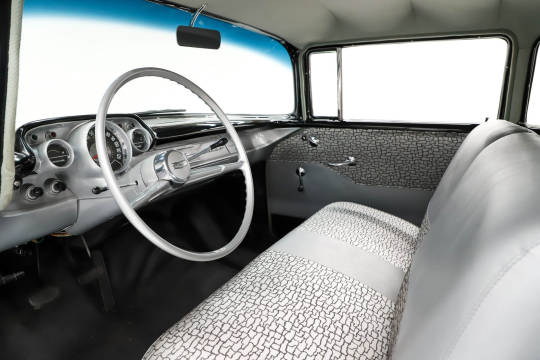
Interior Simplicity
Inside the Black Widow, you’ll find a minimalist design that emphasizes performance over luxury. There are no frills, not even a back seat! The rear windows are stationary, and amenities such as armrests, visors, and even a dome light are absent. However, this simplicity only adds to the car’s authenticity and racing pedigree.
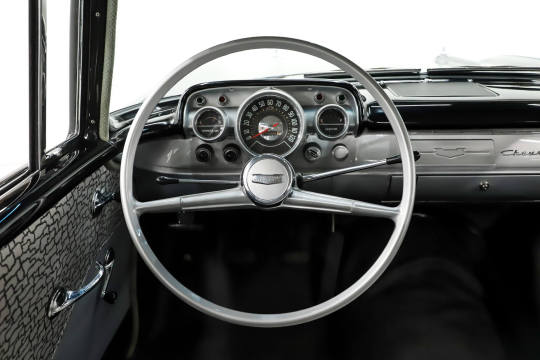
Attention to Detail
No aspect of the Black Widow’s restoration has been overlooked, including the trunk compartment. Painted in glossy white, it exudes cleanliness and attention to detail. A reproduction mat, seat divider, and weatherstrip have been added to complete the authentic look. Even the spare tire matches the original style with its 6 lug pattern and reproduction Firestone tire.

The Heart of a Champion
Under the hood lies a highly detailed engine compartment that exemplifies show-quality craftsmanship. The 283 cubic-inch V8 engine has been built to its original 283 horsepower specifications, complete with a correct factory fuel injection setup. Not only does it look stunning, but it also performs flawlessly. With a responsive throttle and a distinctive idle, this powerhouse truly embodies the spirit of a race car.

A Masterpiece Underneath
The detailed restoration extends to the underside of the car as well. The chassis has been meticulously prepped and painted in a smooth gloss black finish. Every component has been rebuilt, replaced, restored, and detailed to match the original specifications. The Black Widow features front and rear sway bars, as well as the unique duplication of two shocks at each rear wheel for enhanced performance.
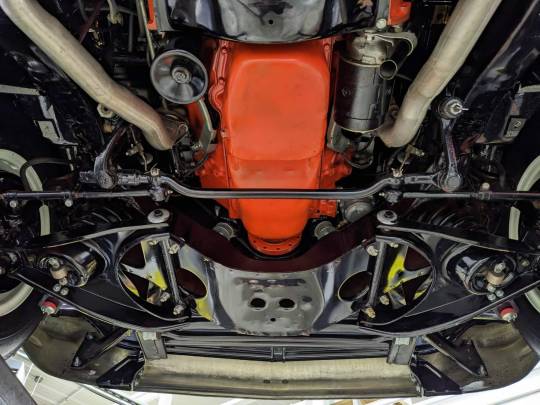
A True Muscle Car
With its completely rebuilt brake system, all-new fuel system, and Flowmaster dual exhaust, this Black Widow not only looks and sounds like a classic muscle car but also performs like one. The spotless Chevy Orange engine block, lower plug wire shielding, canister-type oil filter, restored starter, and dated 1957 transmission all contribute to creating an authentic driving experience. The floors, braces, and rockers have been meticulously restored to their original factory red oxide primer finish.
101 notes
·
View notes
Text
Buddhism: The Journey of the Mind and Spirit to Enlightenment

Buddhism is one of the world’s oldest and most influential religions and spiritual philosophies, with roots dating back to the sixth century BCE in India. Founded by the teachings of Siddhartha Gautama, the Buddha, Buddhism has spread throughout Asia and beyond, shaping the cultures, art, literature, and spiritual practices of many societies. More than a religion in the traditional sense, Buddhism offers a philosophical and ethical path to self-knowledge, detachment, and the pursuit of enlightenment. This article explores the origins, fundamental teachings, and lasting impact of Buddhism.
The Origins of Buddhism: The Life of Siddhartha Gautama
Siddhartha Gautama was born around 563 BCE in Lumbini, present-day Nepal, into a royal family. From an early age, he was sheltered from the painful realities of life, living in a palace surrounded by luxury. However, upon leaving the palace and seeing the suffering of the world—represented by the visions of an old man, a sick man, a corpse, and an ascetic—Siddhartha realized the impermanence of life and decided to abandon his privileged existence to seek an answer to human suffering.
After years of spiritual searching, Siddhartha practiced deep meditation, asceticism, and studied with various teachers, but it was under a fig tree, known as the Bodhi Tree, that he finally achieved enlightenment, becoming the Buddha, which means “The Awakened One.” He spent the rest of his life teaching the principles he discovered, offering a path to the cessation of suffering, known as the Eightfold Path.
The Fundamental Teachings of Buddhism
Buddhism is based on a series of teachings that seek to guide practitioners in understanding the nature of life and in the pursuit of enlightenment. Among the central tenets are the Four Noble Truths and the Eightfold Path.
The Four Noble Truths:
The Truth of Suffering (Dukkha): Life is permeated by suffering, dissatisfaction, and impermanence.
The Truth of the Origin of Suffering: Suffering is caused by craving and attachment, which lead to frustration and pain.
The Truth of the Cessation of Suffering: It is possible to overcome suffering through detachment and understanding.
The Truth of the Path to the Cessation of Suffering: The Eightfold Path is the practical route leading to liberation.
The Eightfold Path:
Right Understanding: Knowing the reality of the Four Noble Truths.
Right Thought: Cultivating the intention of renunciation, goodwill, and nonviolence.
Right Speech: Avoiding lies, slander, hurtful words, and idle talk. - Right Action: Behaving ethically, refraining from killing, stealing, or sexual misconduct.
Right Livelihood: Choosing an occupation that does not cause harm to other beings.
Right Effort: Striving to avoid negative thoughts and cultivating positive ones.
Mindfulness: Maintaining awareness of the body, feelings, mind, and phenomena.
Right Concentration: Practicing meditation to achieve higher states of mind and enlightenment.
Types of Buddhism: Diversity in Practices and Traditions
Buddhism expanded rapidly after the Buddha's death, dividing into several schools and traditions that reflected different interpretations of the original teachings.
Theravada (The Way of the Elders): Predominant in Southeast Asia (Thailand, Myanmar, Sri Lanka), this tradition closely follows the Buddha's original teachings, with an emphasis on monastic practice and meditation.
Mahayana (The Great Vehicle): With roots in China, Japan, and Korea, Mahayana emphasizes compassion and the path of the bodhisattva—one who seeks enlightenment not just for oneself but to help all beings.
Vajrayana (The Diamond Vehicle): Developed primarily in Tibet, it combines elements of Mahayana Buddhism with esoteric rituals and tantric practices to achieve enlightenment quickly.
Zen Buddhism: Originating in China (as Chan) and later developed in Japan, Zen focuses on meditation (zazen) and direct experience of reality, emphasizing simplicity and self-knowledge.
Buddhist Philosophy: Karma, Samsara, and Nirvana
Buddhism is not just a series of rituals, but a profound philosophy that addresses the nature of the mind and the universe. Central to this is the concept of karma – the idea that intentional actions, good or bad, generate consequences that shape the cycle of birth, death and rebirth, known as samsara. The ultimate goal of the Buddhist practitioner is to attain nirvana, a state of liberation and complete cessation of suffering.
Legacy and Influence of Buddhism
Buddhism’s impact has transcended religion, profoundly influencing the art, literature, politics and philosophy of many cultures. Buddhist monasteries were centers of learning, preserving sacred texts and
Legacy and Influence of Buddhism
Buddhism’s impact has transcended religion, profoundly influencing the art, literature, politics, and philosophy of many cultures. Buddhist monasteries were centers of learning, preserving sacred texts and promoting education. Buddhist iconography—from serene statues of the Buddha to intricate mandalas—continues to inspire.
In the West, Buddhism gained popularity in the 20th century, especially through meditation and mindfulness, which were adapted as wellness practices separate from religious contexts. Figures such as the Dalai Lama and Thich Nhat Hanh have become global ambassadors for peace and Buddhist philosophy.
Buddhism in the Modern World
Today, Buddhism continues to grow and adapt, with an estimated half a billion followers worldwide. Buddhist traditions remain vibrant, from remote monasteries in the Himalayas to urban centers in the West. In a world marked by stress and the search for meaning, the Buddha’s teachings on compassion, wisdom, and self-mastery resonate as a guide to a more conscious and harmonious life.
Buddhism is not just a religion; it is a philosophy that offers a path to a deeper understanding of the mind and existence. With its timeless teachings, Buddhism invites each individual to explore their own experience, cultivate compassion, and seek true inner freedom.
16 notes
·
View notes
Text
Comfort Stay Lodge in Thrissur – Your Home Away from Home
A comfortable lodge in the heart of Thrissur, offering a peaceful stay with easy access to temples, culture, and nature. Perfect for travelers and pilgrims.
Thrissur, often referred to as the cultural capital of Kerala, is a city that blends tradition, spirituality, and natural beauty. Whether you're visiting for pilgrimage, leisure, or business, finding the right place to stay is essential for a comfortable trip. Comfort Stay Lodge in Thrissur is designed to offer a homely yet luxurious experience, catering to budget-conscious travelers, families, and pilgrims alike. With its prime location, well-equipped rooms, and excellent service, this lodge ensures a relaxing stay while providing easy access to the city’s most famous attractions.
Prime Location for a Hassle-Free Stay
One of the standout features of Comfort Stay Lodge is its strategic location in the heart of Thrissur. Being close to major transportation hubs, restaurants, shopping centers, and tourist attractions, this lodge is an ideal choice for all types of visitors. Guests can explore the city's vibrant markets, indulge in authentic Kerala cuisine, and visit renowned cultural and spiritual sites within minutes.
Nearby attractions include:
Vadakkunnathan Temple – A UNESCO-recognized heritage site and a must-visit spiritual landmark.
Guruvayur Temple – One of the most revered Krishna temples in India, just a short drive away.
Thrissur Zoo and State Museum – Perfect for history and nature lovers.
Shakthan Thampuran Palace – A glimpse into the royal history of Kerala.
Athirappilly Waterfalls – A breathtaking natural wonder within reach.
Comfortable Accommodation for Every Traveler
Comfort Stay Lodge is designed to suit a wide range of travelers, from solo backpackers to families and business professionals. The lodge offers different types of rooms tailored to meet various needs:
Standard Rooms – Perfect for budget travelers looking for a cozy and affordable stay.
Deluxe Rooms – Spacious and well-furnished rooms with modern amenities for a comfortable experience.
Family Suites – Ideal for families or small groups, offering extra space and privacy.
Executive Rooms – Designed for business travelers, featuring a work desk and high-speed Wi-Fi.
All rooms come with:
Air conditioning
Comfortable beds with fresh linens
Free Wi-Fi access
24-hour room service
Attached bathrooms with modern fittings
Television with satellite channels
Daily housekeeping service
Budget Stay with Premium Comfort
One of the highlights of Comfort Stay Lodge is its affordability without compromising on quality. Whether you're a budget traveler or a family looking for a reasonable stay, this lodge offers great value for money. Guests can enjoy premium amenities, friendly hospitality, and a clean and secure environment at an economical price.
Dining and Local Cuisine
Thrissur is a paradise for food lovers, and staying at Comfort Stay Lodge puts you in close proximity to some of the best local eateries and restaurants. Guests can savor authentic Kerala delicacies like Puttu and Kadala Curry, Kerala Sadya, Karimeen Pollichathu, and more. The lodge also offers an in-house dining facility that serves delicious and hygienic meals, catering to different dietary preferences.
Facilities and Services
Comfort Stay Lodge offers a range of facilities to ensure guests have a pleasant stay:
24/7 Front Desk Assistance – For all your queries and requirements.
Free Parking – Secure parking space for guests with vehicles.
Travel Assistance & Sightseeing Arrangements – Helping guests explore Thrissur with ease.
Laundry Service – Hassle-free laundry solutions for long-term travelers.
Doctor on Call – Ensuring guests' safety and well-being.
Perfect for Pilgrims and Spiritual Seekers
Thrissur is home to many famous temples, churches, and spiritual centers. Pilgrims visiting the city will find Comfort Stay Lodge an excellent choice due to its peaceful ambiance and proximity to major religious sites. The lodge offers special services for pilgrims, including early check-in and late check-out options to accommodate temple visit schedules.
Exploring the Cultural Capital
Thrissur is synonymous with vibrant cultural festivals and traditional arts. Visitors staying at Comfort Stay Lodge can experience:
Thrissur Pooram – One of the grandest temple festivals in India, featuring magnificent elephants and fireworks.
Kathakali & Mohiniyattam Performances – Traditional dance forms that showcase Kerala’s artistic heritage.
Kerala Kalamandalam – A renowned center for learning classical arts.
Safety and Hygiene
Comfort Stay Lodge places a high emphasis on hygiene and guest safety. The premises are regularly sanitized, and strict cleanliness protocols are followed to ensure a worry-free stay. The lodge also features CCTV surveillance, trained staff, and round-the-clock security for added peace of mind.
Easy Booking and Affordable Packages
Booking a stay at Comfort Stay Lodge is hassle-free, with multiple options available:
Online booking through the official website and travel portals.
Walk-in reservations.
Customized stay packages for families, business travelers, and pilgrims.
If you're planning a trip to Thrissur and looking for a place that offers affordable luxury, comfort, and easy access to the city's cultural and spiritual landmarks, Comfort Stay Lodge is the perfect choice. With its well-equipped rooms, excellent service, and budget-friendly rates, this lodge truly feels like a home away from home. Whether you’re here for a spiritual journey, a cultural exploration, or a relaxing getaway, Comfort Stay Lodge ensures a memorable stay in the heart of Thrissur.
2 notes
·
View notes
Text
Discover the Royal Charm of Rajasthan on Two Wheels
Embark on the Adventure of a Lifetime with Le Tour de India’s “Best of Rajasthan on Bicycle” Tour!

If you are an active traveler seeking adventure, culture, and relaxation all in one, then the 12-night, 13-day Rajasthan Cycling Tour by Le Tour de India is it. Here you are pedaling through vibrant cities like Jaipur, Udaipur, and Jodhpur, twisting through rustic trails of Kumbhalgarh and Jawai, all surrounded by the serene beauty of Chandelao and Pushkar. This carefully crafted tour is an unforgettable journey through the heart of Rajasthan, where history, tradition, and natural beauty converge.
Why Choose the Best of Rajasthan on Bicycle Tour with Le Tour de India?
Indulge in the Colours of Rajasthan Le Tour de India cycling tours are much beyond the run-of-the-mill tourist experience. You will not only visit attractions like the Taj Mahal at Agra or Amber Fort in Jaipur, but also uncover quaint villages such as Kumbhalgarh and Jawai. Engulf yourself in rural life experiences. Interact with local artisans, farmers, and folk artists for some unforgettable lifetime moments.
Adventure with Safety and Comfort Le Tour de India will take every precaution to ensure that you feel completely safe and comfortable. It provides high-quality mountain bikes, helmets, tour guides, and a support vehicle, so you will never have any trouble during the tour. It will be of utmost help if you are a serious cyclist or a casual rider; Le Tour de India will help you at every step.
Enjoy Rajasthan's Cuisine Taste the delectable cuisine of Rajasthan to fuel your adventure. With Le Tour de India, you will have the pleasure of enjoying savory treats like dal bati churma, fresh-off-the-hob chapatis, and refreshing local beverages. Every stop is planned carefully to savor the best of local flavors while cycling through picturesque landscapes.
Unique and Comfortable Stays Relax and rejuvenate in boutique heritage properties that reflect Rajasthan's royal legacy. Le Tour de India takes care of the accommodations, which range from quaint forts to converted palaces, as a luxury respite after a day of cycling.
Professionally Guided for Maximum Enjoyment Le Tour de India's guiding staff are very well-experienced adventurers who share a deep appreciation for the state of Rajasthan. They are all very knowledgeable and passionate about storytelling, which will undoubtedly make your time spent discovering local gems, communities, and great rides a far more enjoyable journey.
Tour Highlights
Delhi, the capital city of India, is explored with a free day to acclimatize.
Pedal through the quiet streets of Udaipur, City of Lakes.
Wildlife and serene countryside views are to be spotted at Jawai.
Spiritual charm of Pushkar is to be experienced during its iconic fair (seasonal).
Explore Jaipur's royal heritage and iconic palaces.
End your journey with a visit to the magnificent Taj Mahal in Agra.
Tour Details with Le Tour de India
Dates: Multiple departures from November 2025 to March 2026.
Cost: Starting at $2,850 per person (special discounts for groups and early bookings).
Inclusions: Accommodation, meals, high-quality bikes, local guides, and more.
Who Is This Tour For?
The "Best of Rajasthan on Bicycle" tour by Le Tour de India is perfect for adventure enthusiasts, culture lovers, and anyone seeking a unique and active holiday. Whether you're a solo traveler, a couple celebrating a special occasion, or a group of friends, this cycling tour offers something for everyone.
How to Book
Spaces are limited, so secure your spot today! For more details and booking information, contact the team at Le Tour de India.
2 notes
·
View notes
Text
Mumbai Toll Charges: No Fees for Small Cars at Busy Entry Points
Maharashtra government exempts toll fees for small cars at five key entry toll naka points to Mumbai. Significant relief for daily commuters.
#automotive#auto news#automobile#autos#cars#electric vehicles#news#luxury cars#electric cars#Mumbai#India
0 notes
Text
Chauffeur service
When looking for a professional chauffeur service, The International Travel House is your ideal choice. Providing a wide range of luxurious vehicles, their chauffeur service ensures comfort, hygiene, and safety while maintaining punctuality. Whether for business or leisure, their chauffeur service combines the convenience of modern technology with personalized attention for an exceptional experience.
2 notes
·
View notes
Text
#Bulletproof Cars in India#Bulletproof Luxury Cars In India#bulletproof cars manufacturers#Bulletproof car manufacturers in India#bulletproof vehicle manufacturers in India#Top Armored Cars Company in India#bulletproof luxury cars#Armored Vehicle Manufacturers In India#top armored car manufacturers#Armored Vehicle Company#top armored car companies
0 notes
Photo
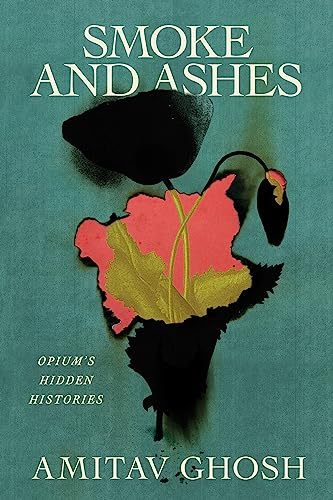
Smoke and Ashes: Opium's Hidden Histories
"Smoke and Ashes: Opium’s Hidden Histories" is a sweeping and jarring work of how opium became an insidious capitalistic tool to generate wealth for the British Empire and other Western powers at the expense of an epidemic of addiction in China and the impoverishment of millions of farmers in India. The legacy of this “criminal enterprise,” as the author puts it, left lasting influences that reverberate across cultures and societies even today.
Written in engaging language, Smoke and Ashes is a scholarly follow-up to the author’s famous Ibis trilogy, a collection of fiction that uses the opium trade as its backdrop. In Smoke and Ashes, the author draws on his years-long research into opium supplemented by his family history, personal travels, cross-cultural experience, and expertise in works of historical verisimilitude. Composed over 18 chapters, the author delves into a diverse set of primary and secondary data, including Chinese sources. He also brings a multidimensional angle to the study by highlighting the opium trade's legacy in diverse areas such as art, architecture, horticulture, printmaking, and calligraphy. 23 pictorial illustrations serve as powerful eyewitness accounts to the discourse.
This book should interest students and scholars seeking historical analysis based on facts on the ground instead of colonial narratives. Readers will also find answers to how opium continues to play an outsize role in modern-day conflicts, addictions, corporate behavior, and globalism.
Amitav Ghosh’s research convincingly points out that while opium had always been used for recreational purposes across cultures, it was the Western powers such as the British, Portuguese, the Spaniards, and the Dutch that discovered its significant potential as a trading vehicle. Ghosh adds that colonial rulers, especially the British, often rationalized their actions by arguing that the Asian population was naturally predisposed to narcotics. However, it was British India that bested others in virtually monopolizing the market for the highly addictive Indian opium in China. Used as a currency to redress the East India Company (EIC)’s trade deficit with China, the opium trade by the 1890s generated about five million sterling a year for Britain. Meanwhile, as many as 40 million Chinese became addicted to opium.
Eastern India became the epicenter of British opium production. Workers in opium factories in Patna and Benares toiled under severe conditions, often earning less than the cost of production while their British managers lived in luxury. Ghosh asserts that opium farming permanently impoverished a region that was an economic powerhouse before the British arrived. Ghosh’s work echoes developmental economists such as Jonathan Lehne, who has documented opium-growing communities' lower literacy and economic progress compared to their neighbors.
Ghosh states that after Britain, “the country that benefited most from the opium trade” with China, was the United States. American traders skirted the British opium monopoly by sourcing from Turkey and Malwa in Western India. By 1818, American traders were smuggling about one-third of all the opium consumed in China. Many powerful families like the Astors, Coolidges, Forbes, Irvings, and Roosevelts built their fortunes from the opium trade. Much of this opium money, Ghosh shows, also financed banking, railroads, and Ivy League institutions. While Ghosh mentions that many of these families developed a huge collection of Chinese art, he could have also discussed that some of their holdings were most probably part of millions of Chinese cultural icons plundered by colonialists.
Ghosh ends the book by discussing how the EIC's predatory behaviors have been replicated by modern corporations, like Purdue Pharma, that are responsible for the opium-derived OxyContin addiction. He adds that fossil fuel companies such as BP have also reaped enormous profits at the expense of consumer health or environmental damage.
Perhaps one omission in this book is that the author does not hold Indian opium traders from Malwa, such as the Marwaris, Parsis, and Jews, under the same ethical scrutiny as he does to the British and the Americans. While various other works have covered the British Empire's involvement in the opium trade, most readers would find Ghosh's narrative of American involvement to be eye-opening. Likewise, his linkage of present-day eastern India's economic backwardness to opium is both revealing and insightful.
Winner of India's highest literary award Jnanpith and nominated author for the Man Booker Prize, Amitav Ghosh's works concern colonialism, identity, migration, environmentalism, and climate change. In this book, he provides an invaluable lesson for political and business leaders that abdication of ethics and social responsibility have lasting consequences impacting us all.
Continue reading...
19 notes
·
View notes